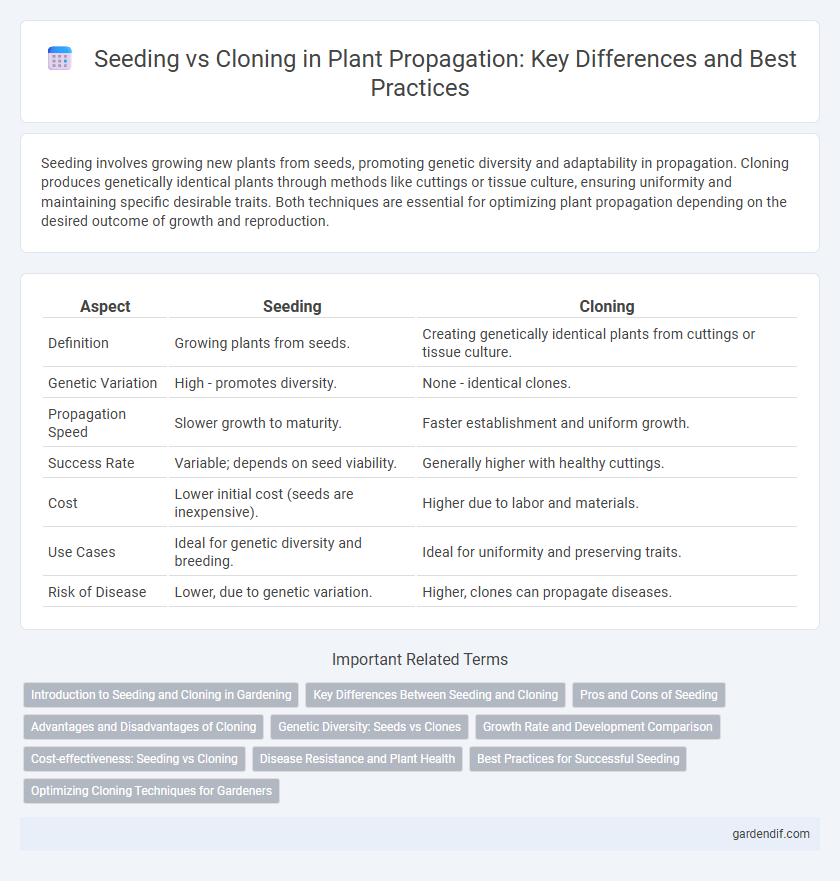
Seeding vs Cloning Illustration
Seeding involves growing new plants from seeds, promoting genetic diversity and adaptability in propagation. Cloning produces genetically identical plants through methods like cuttings or tissue culture, ensuring uniformity and maintaining specific desirable traits. Both techniques are essential for optimizing plant propagation depending on the desired outcome of growth and reproduction.
Table of Comparison
| Aspect | Seeding | Cloning |
|---|---|---|
| Definition | Growing plants from seeds. | Creating genetically identical plants from cuttings or tissue culture. |
| Genetic Variation | High - promotes diversity. | None - identical clones. |
| Propagation Speed | Slower growth to maturity. | Faster establishment and uniform growth. |
| Success Rate | Variable; depends on seed viability. | Generally higher with healthy cuttings. |
| Cost | Lower initial cost (seeds are inexpensive). | Higher due to labor and materials. |
| Use Cases | Ideal for genetic diversity and breeding. | Ideal for uniformity and preserving traits. |
| Risk of Disease | Lower, due to genetic variation. | Higher, clones can propagate diseases. |
Introduction to Seeding and Cloning in Gardening
Seeding in gardening involves growing plants from seeds, offering genetic diversity and adaptability, while cloning produces identical plant copies through cuttings or tissue culture, ensuring uniformity and preserving desirable traits. Seed propagation is essential for developing new varieties and enhancing resilience, whereas cloning accelerates plant production and maintains consistent quality in crops. Both methods play crucial roles in horticulture, balancing innovation with stability in plant cultivation.
Key Differences Between Seeding and Cloning
Seeding involves growing plants from seeds, allowing genetic variation and natural adaptation, while cloning produces genetically identical copies through cuttings or tissue culture. Seeding requires longer time for plants to mature and may result in diverse traits, whereas cloning ensures uniformity and rapid propagation of desirable characteristics. The choice between seeding and cloning depends on goals for genetic diversity, growth speed, and consistency in plant traits.
Pros and Cons of Seeding
Seeding offers genetic diversity and adaptability, making it ideal for crops requiring resilience to changing environmental conditions. It is cost-effective and simple, enabling large-scale propagation with minimal specialized equipment. However, seeding results in variable offspring quality and slower maturation compared to cloning, which can produce uniform, disease-free plants rapidly.
Advantages and Disadvantages of Cloning
Cloning offers the advantage of producing genetically identical plants, ensuring uniformity in traits such as growth rate, flower color, and disease resistance, which is crucial for commercial propagation. However, cloning can lead to a lack of genetic diversity, increasing vulnerability to pests, diseases, and environmental changes, potentially reducing long-term crop resilience. Additionally, cloning requires specialized equipment and expertise, making it more resource-intensive compared to seeding.
Genetic Diversity: Seeds vs Clones
Seeding promotes genetic diversity by combining genetic material from two parent plants, resulting in offspring with varied traits that enhance adaptability and resilience. Cloning produces genetically identical plants, preserving desirable characteristics but limiting variation and increasing vulnerability to pests and diseases. Prioritizing seed propagation supports ecosystem stability and long-term species survival through heterogeneous gene pools.
Growth Rate and Development Comparison
Seeding typically results in slower growth rates as plants develop from seeds that require germination and initial root establishment, whereas cloning via cuttings or tissue culture accelerates development by producing genetically identical plants with established root systems. Cloned plants often exhibit uniform growth patterns and faster maturation, enabling earlier harvest cycles compared to seed-grown counterparts. Growth rate and development in cloning are optimized for consistency and speed, making it a preferred method for commercial propagation where rapid production is critical.
Cost-effectiveness: Seeding vs Cloning
Seeding offers a cost-effective propagation method due to lower initial investment in materials and minimal equipment requirements. Cloning incurs higher costs because of specialized tools, labor-intensive processes, and the need for controlled environments to ensure genetic consistency. For large-scale production with uniform quality, cloning justifies the expense despite its higher cost compared to seeding.
Disease Resistance and Plant Health
Seeding promotes genetic diversity, enhancing disease resistance by enabling natural selection of stronger plants. Cloning ensures uniformity, preserving desirable traits but increasing vulnerability to pathogens due to genetic sameness. Integrating seeding for resilience and cloning for trait consistency optimizes plant health management in propagation.
Best Practices for Successful Seeding
Successful seeding requires selecting high-quality seeds with optimal germination rates and maintaining proper soil moisture and temperature conditions to encourage robust root development. Utilizing pre-soaking or scarification techniques can enhance seed coat permeability, increasing sprouting success. Regular monitoring for pests and diseases combined with appropriate nutrient management supports healthy seedling growth and maximizes propagation efficiency.
Optimizing Cloning Techniques for Gardeners
Optimizing cloning techniques involves selecting healthy parent plants with desirable traits to ensure genetic consistency and vigorous growth. Utilizing precise cutting methods, such as making angled cuts and using rooting hormones, significantly improves root development and success rates. Maintaining controlled environmental conditions, including humidity and temperature, accelerates root formation and enhances overall clone survival for gardeners.
Seeding vs Cloning Infographic

 gardendif.com
gardendif.com